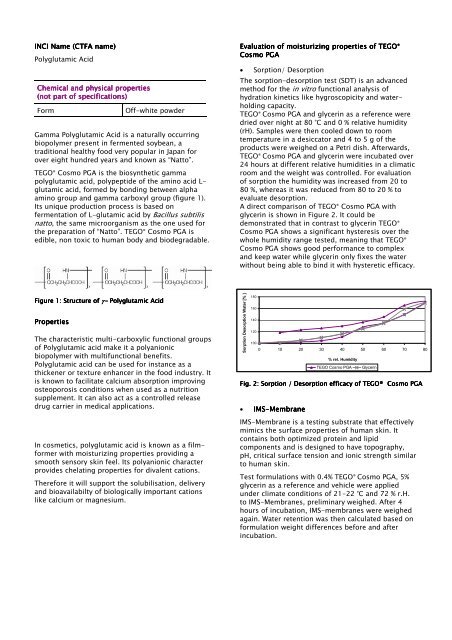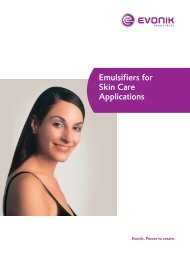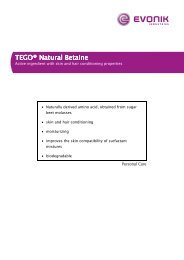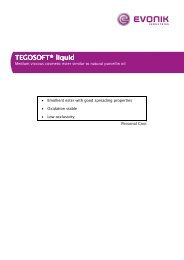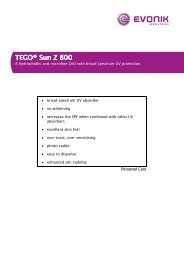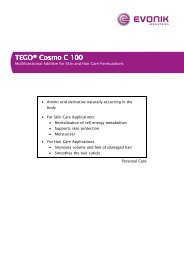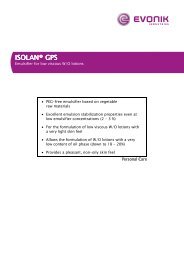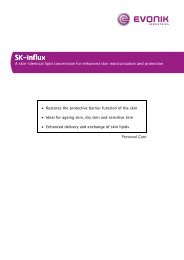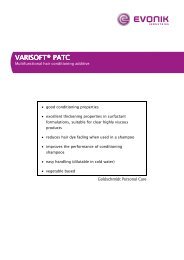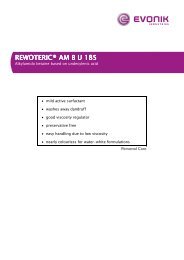TEGO® Cosmo PGA
TEGO® Cosmo PGA
TEGO® Cosmo PGA
Create successful ePaper yourself
Turn your PDF publications into a flip-book with our unique Google optimized e-Paper software.
INCI Name (CTFA name)<br />
Polyglutamic Acid<br />
Chemical and physical properties<br />
(not part of specifications)<br />
Form<br />
Off-white powder<br />
Gamma Polyglutamic Acid is a naturally occurring<br />
biopolymer present in fermented soybean, a<br />
traditional healthy food very popular in Japan for<br />
over eight hundred years and known as “Natto”.<br />
TEGO ® <strong>Cosmo</strong> <strong>PGA</strong> is the biosynthetic gamma<br />
polyglutamic acid, polypeptide of the amino acid L-<br />
glutamic acid, formed by bonding between alpha<br />
amino group and gamma carboxyl group (figure 1).<br />
Its unique production process is based on<br />
fermentation of L-glutamic acid by Bacillus subtilis<br />
natto, the same microorganism as the one used for<br />
the preparation of “Natto”. TEGO ® <strong>Cosmo</strong> <strong>PGA</strong> is<br />
edible, non toxic to human body and biodegradable.<br />
Evaluation of moisturizing properties of TEGO ®<br />
<strong>Cosmo</strong> <strong>PGA</strong><br />
• Sorption/ Desorption<br />
The sorption-desorption test (SDT) is an advanced<br />
method for the in vitro functional analysis of<br />
hydration kinetics like hygroscopicity and waterholding<br />
capacity.<br />
TEGO ® <strong>Cosmo</strong> <strong>PGA</strong> and glycerin as a reference were<br />
dried over night at 80 °C and 0 % relative humidity<br />
(rH). Samples were then cooled down to room<br />
temperature in a desiccator and 4 to 5 g of the<br />
products were weighed on a Petri dish. Afterwards,<br />
TEGO ® <strong>Cosmo</strong> <strong>PGA</strong> and glycerin were incubated over<br />
24 hours at different relative humidities in a climatic<br />
room and the weight was controlled. For evaluation<br />
of sorption the humidity was increased from 20 to<br />
80 %, whereas it was reduced from 80 to 20 % to<br />
evaluate desorption.<br />
A direct comparison of TEGO ® <strong>Cosmo</strong> <strong>PGA</strong> with<br />
glycerin is shown in Figure 2. It could be<br />
demonstrated that in contrast to glycerin TEGO ®<br />
<strong>Cosmo</strong> <strong>PGA</strong> shows a significant hysteresis over the<br />
whole humidity range tested, meaning that TEGO ®<br />
<strong>Cosmo</strong> <strong>PGA</strong> shows good performance to complex<br />
and keep water while glycerin only fixes the water<br />
without being able to bind it with hysteretic efficacy.<br />
Figure 1: Structure of γ- Polyglutamic Acid<br />
Properties<br />
The characteristic multi-carboxylic functional groups<br />
of Polyglutamic acid make it a polyanionic<br />
biopolymer with multifunctional benefits.<br />
Polyglutamic acid can be used for instance as a<br />
thickener or texture enhancer in the food industry. It<br />
is known to facilitate calcium absorption improving<br />
osteoporosis conditions when used as a nutrition<br />
supplement. It can also act as a controlled release<br />
drug carrier in medical applications.<br />
In cosmetics, polyglutamic acid is known as a filmformer<br />
with moisturizing properties providing a<br />
smooth sensory skin feel. Its polyanionic character<br />
provides chelating properties for divalent cations.<br />
Therefore it will support the solubilisation, delivery<br />
and bioavailabilty of biologically important cations<br />
like calcium or magnesium.<br />
Sorption Desorption Water [% ]<br />
180<br />
160<br />
140<br />
120<br />
100<br />
0 10 20 30 40 50 60 70 80<br />
Fig. 2: : Sorption / Desorption efficacy e<br />
of TEGO® <strong>Cosmo</strong> <strong>PGA</strong><br />
• IMS-Membrane<br />
Membrane<br />
% rel. Humidity<br />
TEGO <strong>Cosmo</strong> <strong>PGA</strong><br />
Glycerin<br />
IMS-Membrane is a testing substrate that effectively<br />
mimics the surface properties of human skin. It<br />
contains both optimized protein and lipid<br />
components and is designed to have topography,<br />
pH, critical surface tension and ionic strength similar<br />
to human skin.<br />
Test formulations with 0.4% TEGO ® <strong>Cosmo</strong> <strong>PGA</strong>, 5%<br />
glycerin as a reference and vehicle were applied<br />
under climate conditions of 21-22 °C and 72 % r.H.<br />
to IMS-Membranes, preliminary weighed. After 4<br />
hours of incubation, IMS-membranes were weighed<br />
again. Water retention was then calculated based on<br />
formulation weight differences before and after<br />
incubation.


